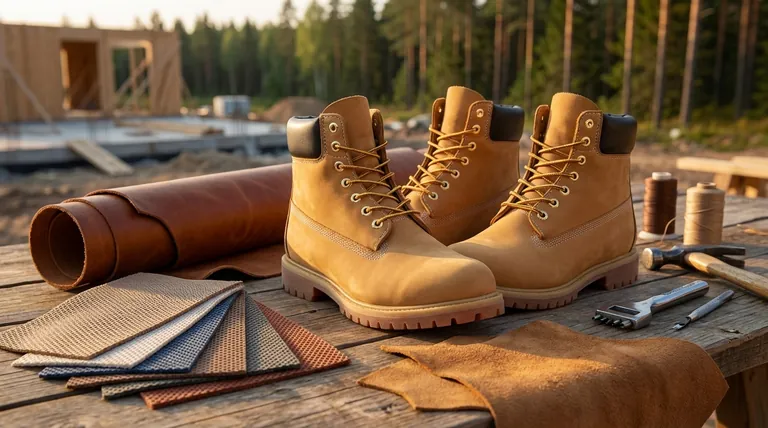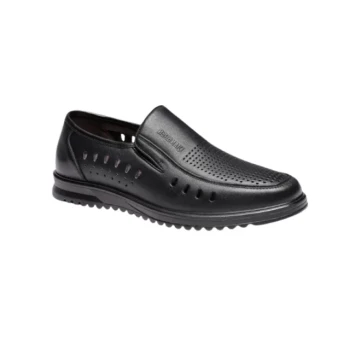At its core, a shoe's upper is constructed from one of three primary material families: leathers, synthetics, and textiles. The specific material, such as full-grain leather, synthetic mesh, or suede, is chosen to give the shoe its defining characteristics, including durability, breathability, and flexibility.
The choice of an upper material is a deliberate engineering decision, not just an aesthetic one. It revolves around balancing the fundamental trade-offs between durability, environmental resistance, breathability, and weight to match the shoe's intended function.

The Primary Material Categories
The vast majority of shoe uppers are made from variations of leather or synthetic fabrics. Each category offers a distinct profile of strengths and weaknesses.
Leather Variants
Leather is prized for its durability, natural breathability, and ability to mold to the foot over time. It is a common choice for work boots, safety footwear, and premium casual shoes.
Common types include:
- Full-Grain Leather: The highest quality and most durable type. It is known for its excellent water resistance, longevity, and being easy to clean.
- Nubuck & Suede: These are leathers that have been sanded to create a soft, velvety texture. They offer a premium look but are less resistant to stains and water than full-grain leather.
- Split-Grain & Action Leather: These are more affordable leather options. They are often more flexible and breathable but typically offer less long-term durability than full-grain.
Synthetic Fabrics
Synthetics are engineered materials designed to offer specific performance benefits, often at a lower weight and cost than leather. They dominate the athletic and outdoor footwear markets.
Common types include:
- Mesh: A woven fabric with visible pores, mesh offers maximum breathability and flexibility. It is the primary material for running and walking shoes.
- Synthetic Leather & Microfibre: These materials mimic the appearance of real leather while providing enhanced water, chemical, or abrasion resistance. They are easy to clean and do not require maintenance.
- Softshell: A category of woven synthetic fabrics that provide a balance of water resistance, breathability, and stretch, common in outdoor and hiking shoes.
Key Performance Factors in Material Selection
The specific purpose of the shoe dictates which material properties are most important. A work boot has very different needs from a running shoe.
Durability and Abrasion Resistance
For footwear exposed to harsh conditions, such as work or hiking boots, durability is paramount. Full-grain leather and robust synthetic fabrics are chosen for their high resistance to tearing and abrasion.
Breathability and Moisture Management
In active footwear, the ability to let heat and moisture escape is critical for comfort. Mesh is the top performer for ventilation, while natural leathers also offer good breathability.
Water and Chemical Resistance
Protecting the foot from external elements is a key function of safety and outdoor shoes. Full-grain leather offers excellent natural waterproofness, while synthetic leathers can be engineered for complete impermeability and resistance to specific chemicals.
Flexibility and Weight
For athletic performance and all-day comfort, minimizing weight and maximizing flexibility is crucial. This is where synthetic mesh and other lightweight fabrics excel, as they place less strain on the wearer.
Understanding the Trade-offs
No single material is perfect for every application. The final choice always involves balancing competing priorities.
Leather: Durability vs. Maintenance
Leather offers unmatched durability and a classic aesthetic, but it comes at a cost. It is generally heavier than synthetics and requires periodic cleaning and conditioning to maintain its water resistance and prevent cracking.
Synthetics: Performance vs. Longevity
Synthetic materials provide targeted performance benefits like extreme breathability or waterproofing at a light weight. However, they typically have a shorter lifespan than high-quality leather and are more prone to breaking down from UV exposure and repeated friction.
The Cost and Quality Factor
Within both leather and synthetics, there is a wide spectrum of quality and cost. For example, "genuine leather" is a lower-grade material than "full-grain leather," just as a cheap mesh will not perform as well as an engineered, abrasion-resistant synthetic textile.
Making the Right Choice for Your Goal
Your primary objective for the footwear should guide the material selection.
- If your primary focus is maximum durability and longevity: Look for footwear made with full-grain leather, as it is best suited for work boots and heavy-duty use.
- If your primary focus is lightweight breathability: Choose shoes with uppers made predominantly of synthetic mesh, ideal for running, walking, and general fitness.
- If your primary focus is balanced weather resistance and performance: Consider a hybrid design that combines leather for structure and durability with synthetic panels for breathability and flexibility, common in hiking boots.
Understanding these material properties empowers you to select footwear that is perfectly engineered for its intended purpose.
Summary Table:
| Material Category | Key Characteristics | Best For |
|---|---|---|
| Leather (e.g., Full-Grain) | High durability, natural breathability, molds to foot | Work boots, safety footwear, premium casual shoes |
| Synthetics (e.g., Mesh) | Lightweight, excellent breathability, targeted performance | Athletic shoes, running shoes, outdoor footwear |
| Textiles (e.g., Suede) | Soft texture, flexible, premium look | Fashion-forward casual and lifestyle shoes |
Ready to source the perfect shoe uppers for your brand? As a large-scale manufacturer, 3515 produces a comprehensive range of footwear for distributors, brand owners, and bulk clients. Our expertise in materials like durable full-grain leather and high-performance synthetics ensures your products are built for success. Let's discuss your specific needs and bring your vision to life. Contact our team today for a consultation.
Visual Guide

Related Products
- Durable Leather Work Boots Wholesale Manufacturer & Custom Factory
- Premium KPU Injection Athletic Style Safety Shoes
- Wholesale Classic Leather Lace-Up Ankle Boots for Brand Manufacturing
- Wholesale Safety Footwear Manufacturer for Bulk & Custom OEM Orders
- Wholesale Breathable Perforated Slip-On Loafers Custom Manufacturing
People Also Ask
- What cultural and environmental considerations are tied to wearing shoes indoors? Balance Hygiene, Tradition, and Foot Health
- What are the initial steps to take care of new work boots? Ensure Long-Term Comfort and Durability
- What should be done before wearing new work boots for the first time? A 3-Step Guide for Optimal Fit & Durability
- What are the steps for caring for engineer boots to ensure longevity? A Guide to Decades of Wear
- What are the cultural perspectives on wearing shoes in the house? A Guide to Home Etiquette & Hygiene



















